Physical Address
304 North Cardinal St.
Dorchester Center, MA 02124
Physical Address
304 North Cardinal St.
Dorchester Center, MA 02124

Master the art of free RV camping across America's wilderness while saving thousands and discovering hidden natural treasures.
Like a key releasing endless possibilities, boondocking opens the door to America’s most breathtaking landscapes without the burden of campground fees. You’ll discover how to camp for free on public lands while maintaining the comforts of your RV lifestyle. Whether you’re a weekend warrior or planning to live off-grid full-time, understanding the essentials of boondocking can transform your travel experience and save you thousands of dollars. Let’s explore how you can start your journey into the world of free camping.
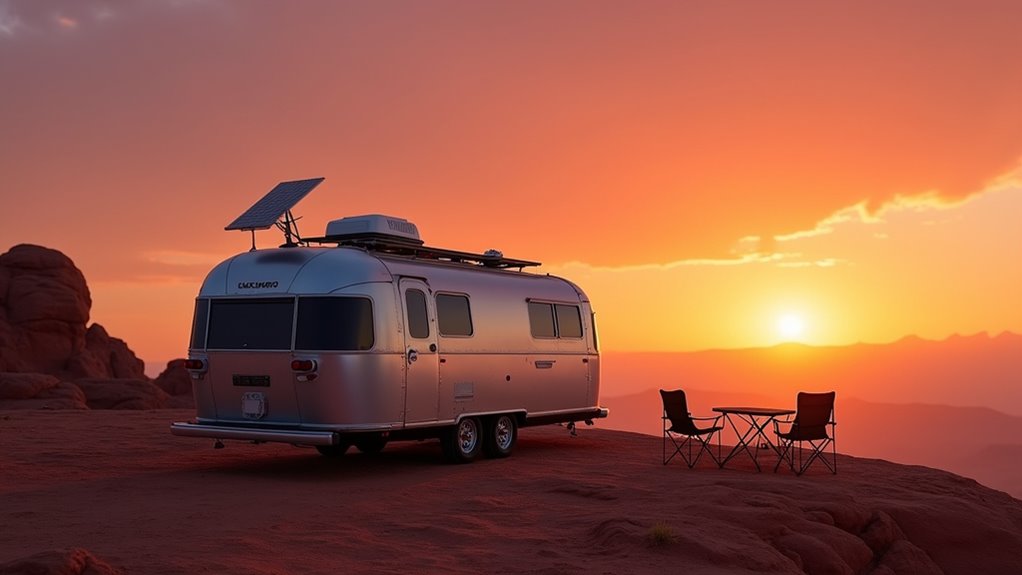
While traditional campgrounds offer predictable amenities and organized spaces, boondocking takes you off the beaten path to camp without hookups in remote, undeveloped areas.
You’ll find yourself on public lands like national forests or BLM land, where you won’t have access to water, electricity, or sewer connections.
Instead of crowded campsites with neighbors just feet away, you’ll enjoy wide-open spaces and true privacy.
Leave the packed campgrounds behind and discover the freedom of boundless wilderness, where solitude replaces shoulder-to-shoulder camping.
There’s no infrastructure – no maintained roads, picnic tables, or fire pits.
Many locations require wider dirt roads that can accommodate larger vehicles and provide adequate turning space.
You’ll need to be completely self-sufficient, relying on your RV’s systems for power, water storage, and waste management.
While traditional campgrounds can cost $30-$100 per night, boondocking is often free or requires minimal permit fees, making it an excellent choice for budget-conscious travelers seeking solitude in nature.
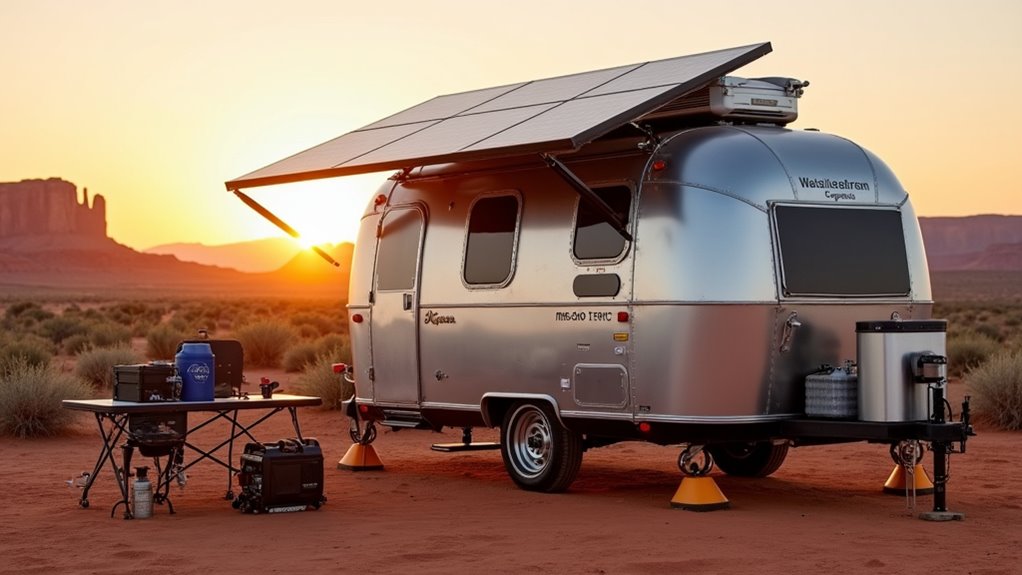
Successful boondocking requires careful planning and the right equipment to stay safe and comfortable in remote locations. To guarantee you’re well-prepared for your off-grid adventure, focus on these essential systems:
Monitor your battery levels carefully to avoid depleting your power source. While continuous AC operation is possible in RVs, it’s best to use it strategically to conserve power.
Install water-saving fixtures to extend your stays. Remember to pack folding chairs and tables to create a comfortable outdoor living space.
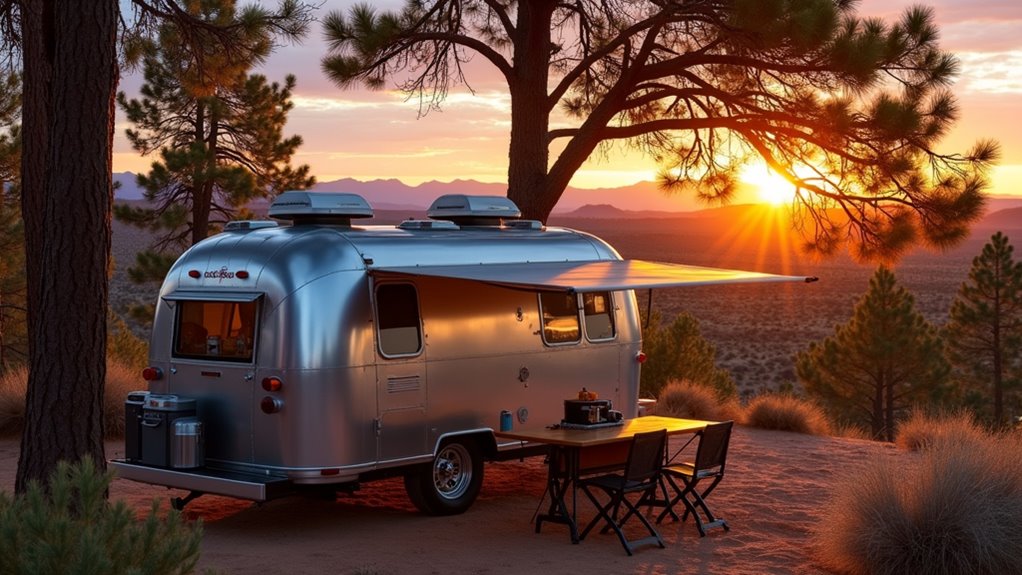
Ready to find your perfect boondocking spot? You’ll find most free camping opportunities on Bureau of Land Management (BLM) lands, which cover 245 million acres across the U.S. These public lands often allow dispersed camping, letting you set up outside designated campgrounds. You’ll typically need to follow the fourteen day limit when staying at any particular site.
Before heading out, use online databases, GPS tools, and satellite imagery to scout potential locations. Apps and community forums can provide real-time updates about site availability and conditions. For BLM lands, you’ll need to follow specific regulations about camping duration and environmental guidelines. Even if you plan to use shore power at some point, maintaining your RV batteries is essential for boondocking flexibility.
If you prefer private property options, join membership programs or connect with landowners through online communities. Always get explicit permission before camping on private land to avoid trespassing issues.
Remember to minimize your impact wherever you camp by properly disposing of waste and respecting wildlife.

Although boondocking offers solitude and freedom, staying safe in remote areas requires thorough preparation and awareness. Your safety depends on smart planning and staying vigilant while enjoying the wilderness.
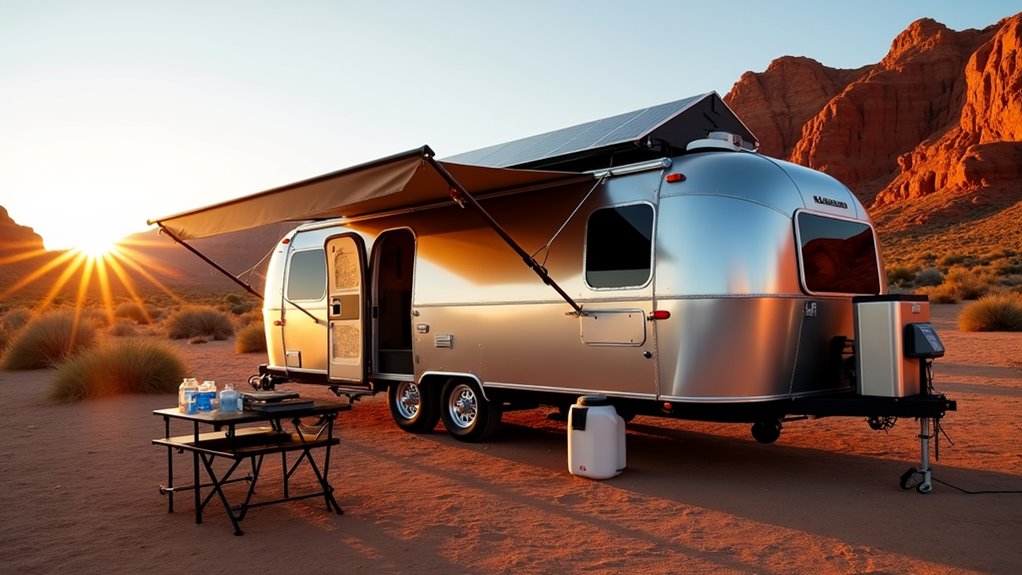
Living off-grid requires mastering the delicate balance of water, power, and waste management to extend your boondocking stays.
You’ll need to adopt military-style showers, using just 2-3 gallons per wash, and consider sponge baths to drastically reduce water consumption. Install water-saving showerheads and collect rainwater when possible. A 40-foot RV roof can collect approximately 100 gallons during just a half-inch rainfall.
For power, switch to LED lights and limit high-power appliance use. Solar panels paired with deep-cycle batteries will keep you charged without generator dependence.
Monitor your energy consumption carefully to adjust habits accordingly.
Minimize grey water production by wiping dishes before washing and using diluted soap mixtures.
Consider portable waste tanks and a macerator pump for flexible disposal options. When possible, capture and reuse grey water for toilet flushing or plant irrigation where permitted.
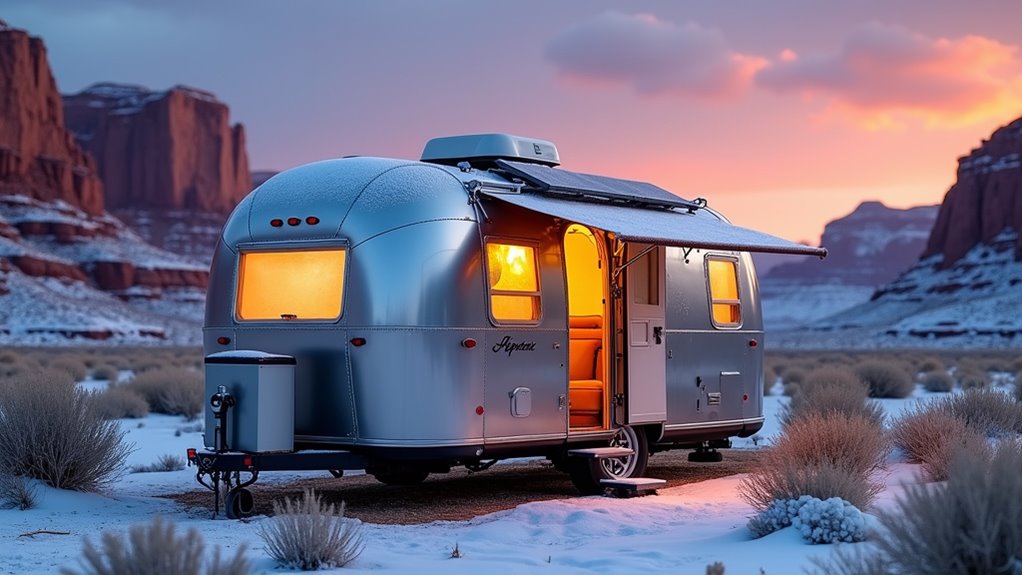
Before venturing into the wilderness, successful boondocking requires a thorough understanding of weather patterns and seasonal challenges.
You’ll need to designate a weather watcher and use multiple methods to receive alerts, as conditions can change rapidly in remote areas. Checking local fire regulations before selecting a campsite is essential for safety and compliance.
Always evaluate cell service availability and terrain conditions before settling in.
During severe weather, stay prepared to evacuate and keep essential safety gear easily accessible.

When boondocking on public lands, you’ll need to navigate a complex web of federal, state, and local regulations that govern free camping.
Most BLM and Forest Service lands allow dispersed camping for up to 14 days within any 28-day period, after which you must move at least 25 miles away. Staying informed about local camping laws through available resources like online forums and guides can help prevent potential issues.
You can’t camp near developed recreation areas, trailheads, or picnic grounds. Always check local signage, as some areas may be temporarily closed.
Each state has its own rules about overnight parking and camping in vehicles, so research your specific location before settling in.
Violating these regulations can result in fines or camping restrictions, so maintain detailed records of your stays.
Remember to obtain any required permits and stick to existing roads and designated spots to minimize environmental impact.
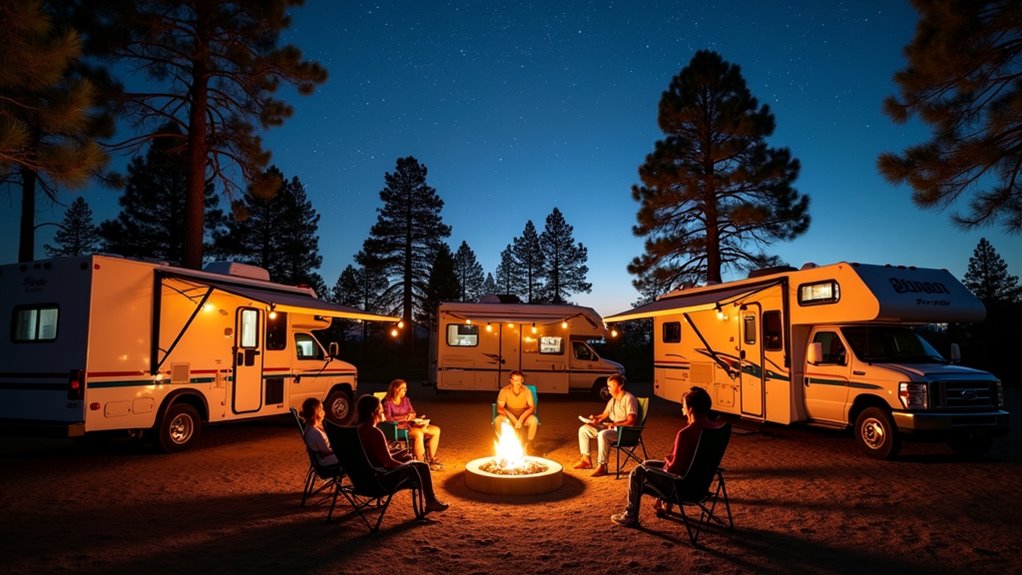
The remote nature of boondocking doesn’t mean you have to go it alone. Building connections with fellow boondockers enhances your safety, enriches your experience, and creates lasting friendships. Many families find that kid-friendly locations make boondocking an excellent opportunity for children to explore nature together.
You’ll find plenty of ways to connect with like-minded travelers who share your passion for free camping. Using apps like Campendium and Allstays, you can discover nearby boondockers and their reviews of camping spots.
Remember to follow established community etiquette and Leave No Trace principles.
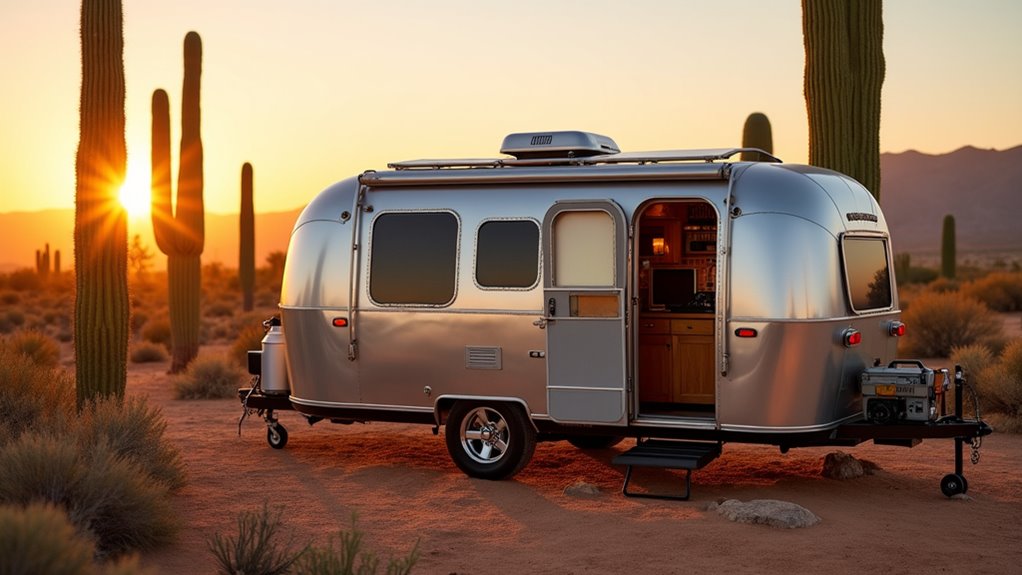
Successful boondocking depends heavily on maintaining your RV’s essential systems, especially during extended off-grid stays.
You’ll need to regularly check your batteries’ water levels and terminals, inspect propane connections for leaks, and uphold your generator according to the manufacturer’s schedule. Exercise your generator with a monthly function test to maintain its reliability.
Don’t neglect your water systems – sanitize your fresh water tank seasonally and check for plumbing leaks using a soap-water solution. Understanding RV travel costs can help you budget for necessary maintenance supplies.
Keep your roof and window seals in good condition by inspecting them every 90 days to prevent water damage.
Test all safety devices, including smoke, CO2, and LP detectors.
Pay special attention to your vehicle’s basics: maintain proper tire pressure, check brake systems, and guarantee even weight distribution.
These maintenance tasks will help prevent costly repairs and keep you safely enjoying your off-grid adventures.
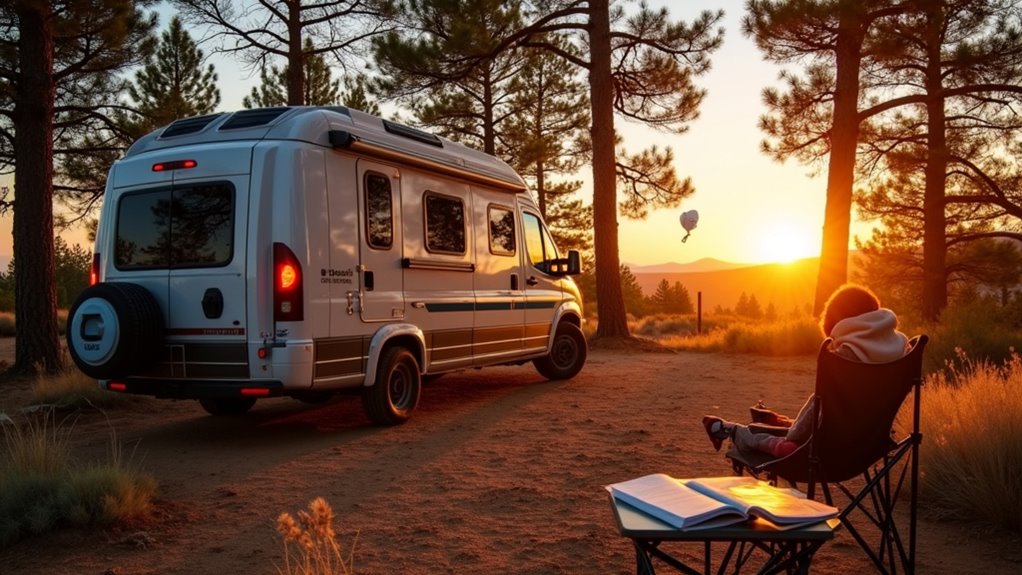
Maintaining your RV sets the foundation for successful boondocking, but smart financial planning determines how long you can stay off-grid. By embracing strategic money-saving approaches, you’ll maximize your boondocking adventure while minimizing expenses.
Smart financial planning and strategic cost-cutting are essential for extending your off-grid adventures and making the most of boondocking life.
You’re now equipped to join the thousands of budget-conscious RVers who’ve discovered boondocking freedom. Take Sarah and Mike from Colorado, who saved $8,000 in camping fees last year by boondocking on BLM land near Moab. With your solar setup, water management skills, and newfound boondocking knowledge, you’ll create your own off-grid adventure while keeping more money in your pocket. Time to hit the road and embrace the simple life.